The Pacific Northwest is home to a diverse range of avian species – from bald eagles to hummingbirds, from sea ducks to songbirds – making it a birder’s paradise.
The region’s varied landscape that includes coastline, vast forests, rugged mountains, verdant wetlands, and arid deserts harbors a wealth of natural habitat for birds.
In fact, it is considered one of the best places in the world for birdwatching, featuring unique and threatened species that are found nowhere else on earth.
The region’s rich cultural, ecological, and economic significance has made it a vital destination for bird enthusiasts from all over the world.
This article provides an overview of bird species found in the Pacific Northwest, their habitat, behavior, and conservation status.
1. Downy Woodpecker
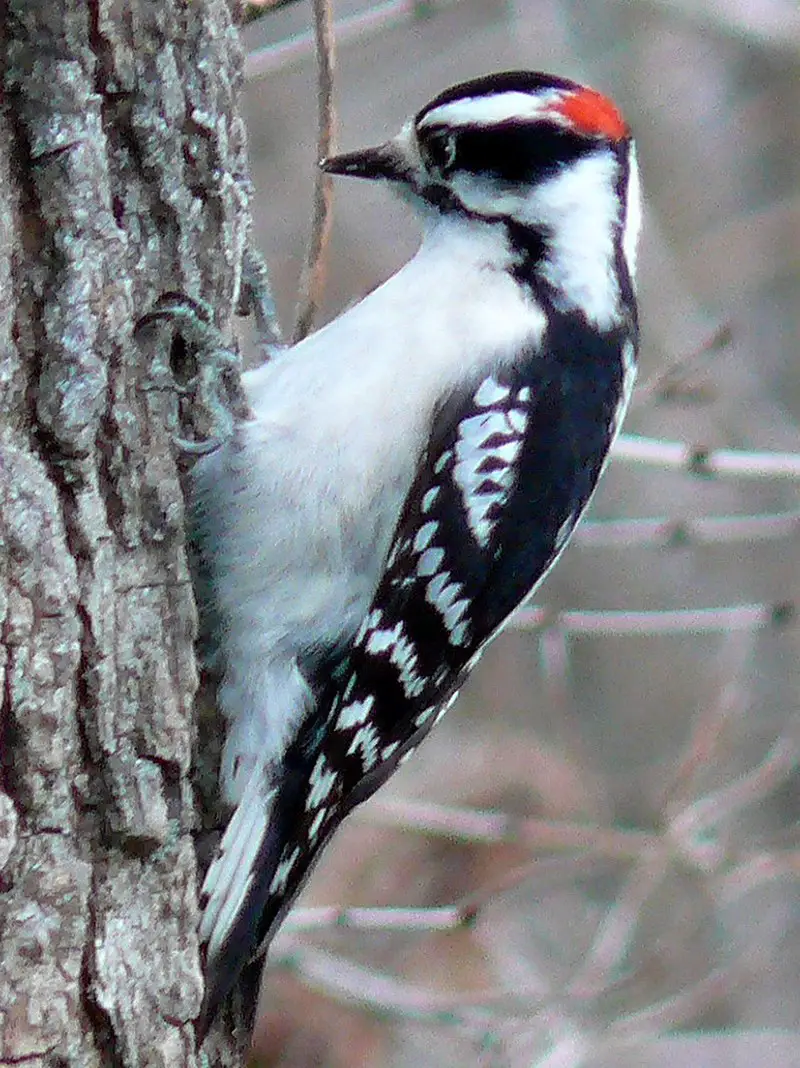
The downy woodpecker is a small species of woodpecker found in North America. Growing up to 7 inches long, it can be identified by its white belly and spotted wings.
It inhabits forests throughout the United States and Canada, with the exception of deserts in the southwest and northern tundra.
This bird nests in tree cavities and feeds mostly on insects but will supplement its diet with fruit or nuts when available.
The Downy Woodpecker has an unmistakable call that sounds like a loud ‘pik-er’, similar to other members of its family such as the Hairy Woodpecker.Scientific classification:
| Kingdom | Animalia |
| Phylum | Chordata |
| Class | Aves |
| Order | Piciformes |
| Family | Picidae |
| Genus | Dryobates |
| Species | D. pubescens |
Also Featured In: Most Common United States Birds, New Hampshire Birds You Should Know
2. American Coot
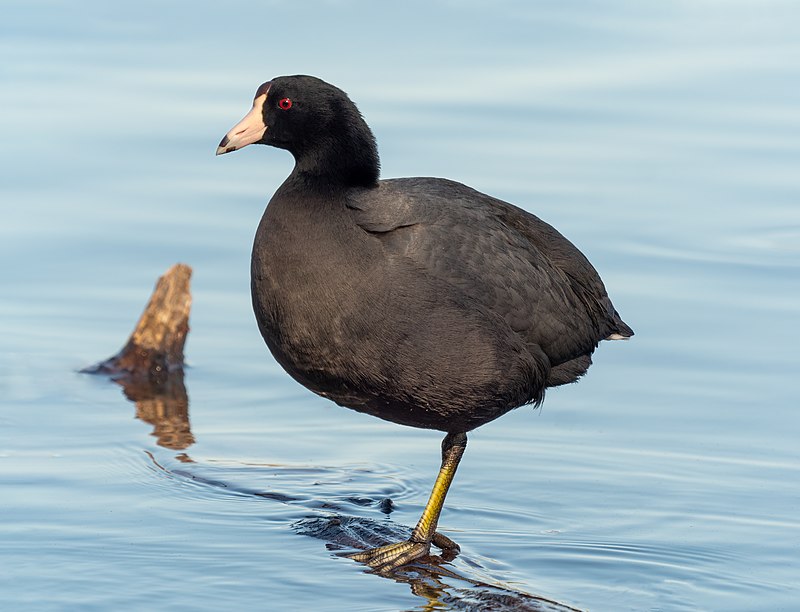
The American coot is a bird of the Rallidae family, commonly mistaken for ducks. However, they are only distantly related and have broad lobed scales on their lower legs and toes that fold back with each step to help them walk on dry land unlike ducks which have webbed feet.
Coots are omnivores who typically live in freshwater marshes, ponds and lakes but can also be found in brackish water habitats or even open oceans during migration season.
They feed mainly on algae and aquatic plants as well as small fish, snails, insects larvae and worms from time to time.
The males display territorial behaviour by chasing away intruders within their territory while females lay eggs mostly.
In floating nests made of vegetation near shorelines or islands among reeds where chicks hatch after about three weeks incubation period before swimming off into adulthood shortly afterwards at 10-12 weeks old.Scientific classification:
| Kingdom | Animalia |
| Phylum | Chordata |
| Class | Aves |
| Order | Gruiformes |
| Family | Rallidae |
| Genus | Fulica |
| Species | F. americana |
Also Featured In: Most Popular Bird Species in North America, Long Island Birds You Should Know
3. American Wigeon
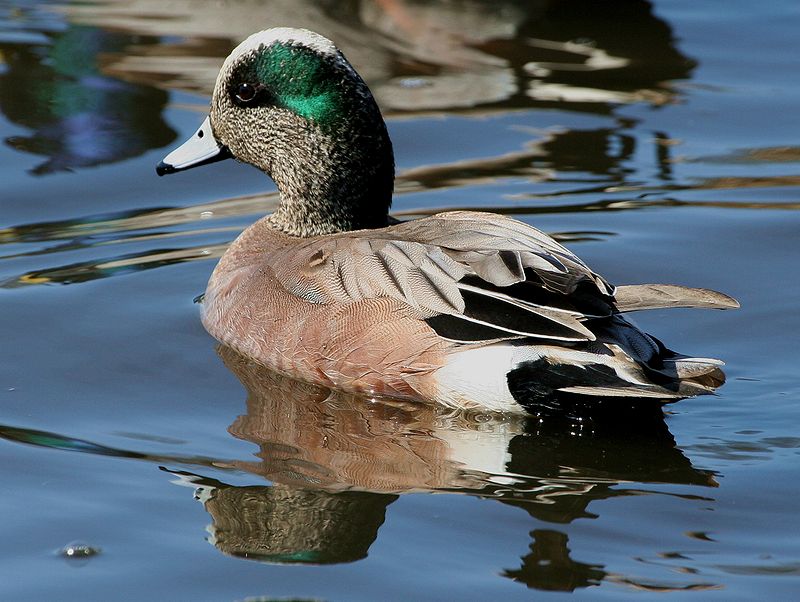
The American Wigeon, also known as the Baldpate, is a species of dabbling duck found throughout North America.
It closely resembles its Eurasian counterpart and was formally described in 1789 by German naturalist Johann Friedrich Gmelin.
This medium-sized bird has an overall grey body with white feathers on its face and belly that give it a distinctive bald appearance.
Its wings are brownish black with green speculum markings on them while the tail is dark brown or black at the base and gradually lightens near tips to become chestnut colored.
The male wigeons have purple patches on their heads during breeding season along with yellow eyes which helps differentiate them from females who have duller colors around their faces instead of bright ones like males possess.Scientific classification:
| Kingdom | Animalia |
| Phylum | Chordata |
| Class | Aves |
| Order | Anseriformes |
| Family | Anatidae |
| Genus | Mareca |
| Species | M. americana |
Also Featured In: British Columbian Birds, Common Birds in Alberta
4. American Dipper
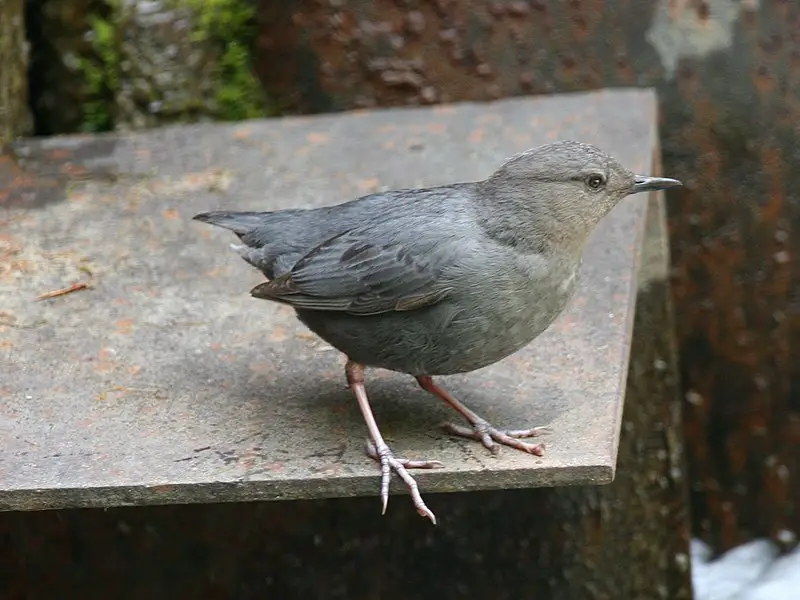
The American dipper is a small but stocky bird found in North America, with grey feathers and white eyelids that cause its eyes to appear to flash.
It measures approximately 16.5 cm (6.5 in) long and has a wingspan of 23 cm (9.1 in).
The average weight for an adult is 46 g (1.6 oz). This species can be identified by its habit of bobbing up and down when it pauses on rocks or logs near rivers or streams.
Hence the nickname ‘water ouzel’. Its diet consists mainly of aquatic insects which are collected from fast-flowing water using the strong claws located at the ends of their toes – amazing.Scientific classification:
| Kingdom | Animalia |
| Phylum | Chordata |
| Class | Aves |
| Order | Passeriformes |
| Family | Cinclidae |
| Genus | Cinclus |
| Species | C. mexicanus |
Also Featured In: Mountain Birds You Should Know, Yellowstone National Park Birds You Need To Know
5. Canada Goose
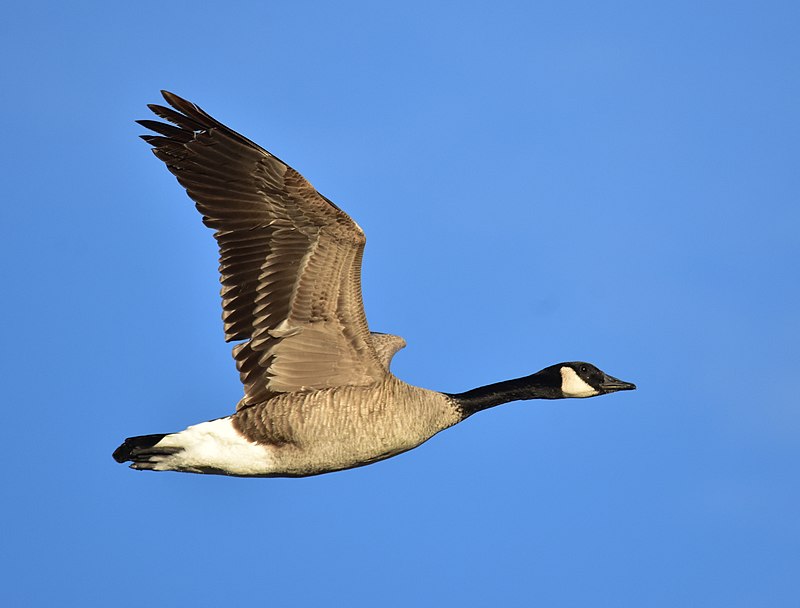
The Canada goose is a majestic bird with a black head and neck, white cheeks, chin and brown body. It’s native to North America but occasionally migrates to northern Europe across the Atlantic.
The species has been introduced in the United Kingdom, Ireland and Finland as well. Canada geese are strong flyers that travel in flocks for protection from predators; they also form monogamous pairs for life.
They feed on grasses or grains near ponds or wetlands where they make their nests of down which incubate eggs during summertime before hatching them out into goslings later on.Scientific classification:
| Kingdom | Animalia |
| Phylum | Chordata |
| Class | Aves |
| Order | Anseriformes |
| Family | Anatidae |
| Genus | Branta |
| Species | B. canadensis |
Also Featured In: Birds that Commonly Found in Pond , Birds that Migrate through Illinois in the Spring
6. Killdeer
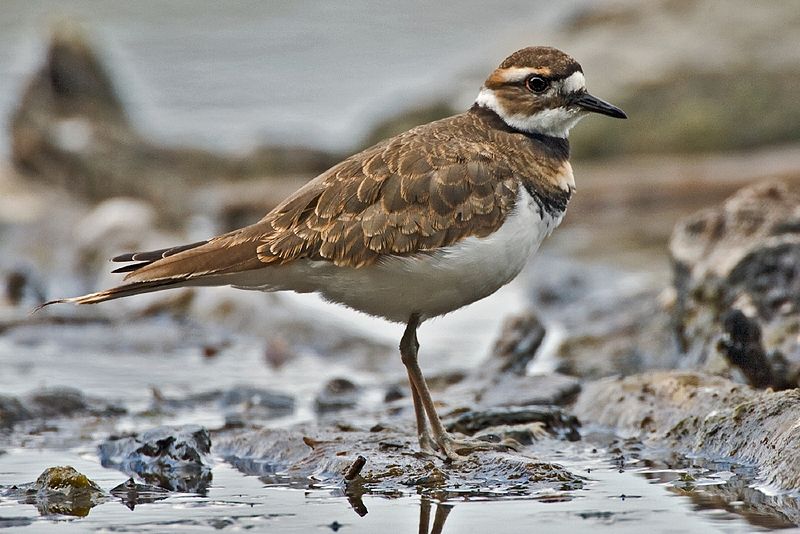
The Killdeer bird is a large plover found in the Americas. It has an unmistakable call which gives it its name, and boasts striking upperparts of brown with rufous fringes.
Its head features patches of white and black, while two distinctive bands adorn its neck – one black above, and one chestnut below.
The undersides are mostly white or pale buff-brown; their wings feature bright orange stripes when they take flight.
During breeding season males perform elaborate courtship rituals to attract females into establishing a pair bond; they also defend territories fiercely against other birds that encroach on them during this time.
In winter months some killdeers migrate southwards but many stay put throughout the cold weather too.
All in all these beautiful creatures provide us with quite a sight indeed.Scientific classification:
| Kingdom | Animalia |
| Phylum | Chordata |
| Class | Aves |
| Order | Charadriiformes |
| Family | Charadriidae |
| Genus | Charadrius |
| Species | C. vociferus |
Also Featured In: Wetlands Birds You Should Know, Common Birds of Houston
7. Bewick’s Wren
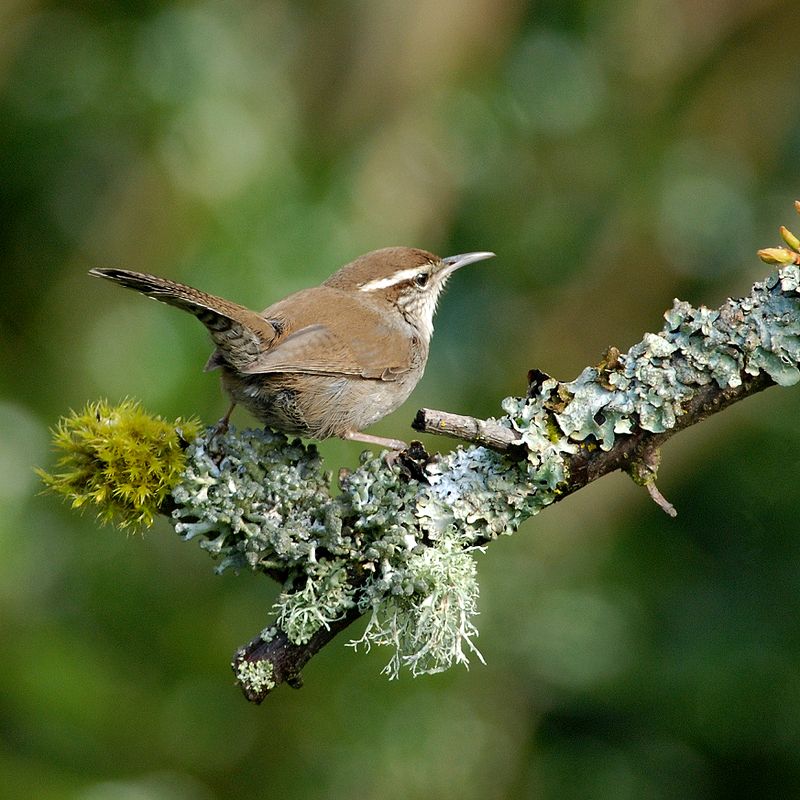
The Bewick’s wren (Thryomanes bewickii) is a small, grey-brown bird native to North America. Measuring at around 14 cm long it has distinctive white markings on its face and tail giving it an attractive appearance.
It can often be found in thickets or scrubby areas as well as urban gardens and parks.
Its song is loud and melodious which makes them popular amongst ornithologists; they are known for their complex vocalisations composed of whistles, clicks, churrs and trills.
The Bewick’s Wren mainly feeds on insects but will also eat fruits if available during the colder months when food may otherwise be scarce.
This species of wren plays an important role in controlling insect populations making them beneficial inhabitants of our environment.Scientific classification:
| Kingdom | Animalia |
| Phylum | Chordata |
| Class | Aves |
| Order | Passeriformes |
| Family | Troglodytidae |
| Genus | Thryomanes P.L. Sclater, 1862 |
| Species | T. bewickii |
Also Featured In: Top Birds Found in Mexico, Brown Birds that Live in West Virginia
8. Northern Goshawk
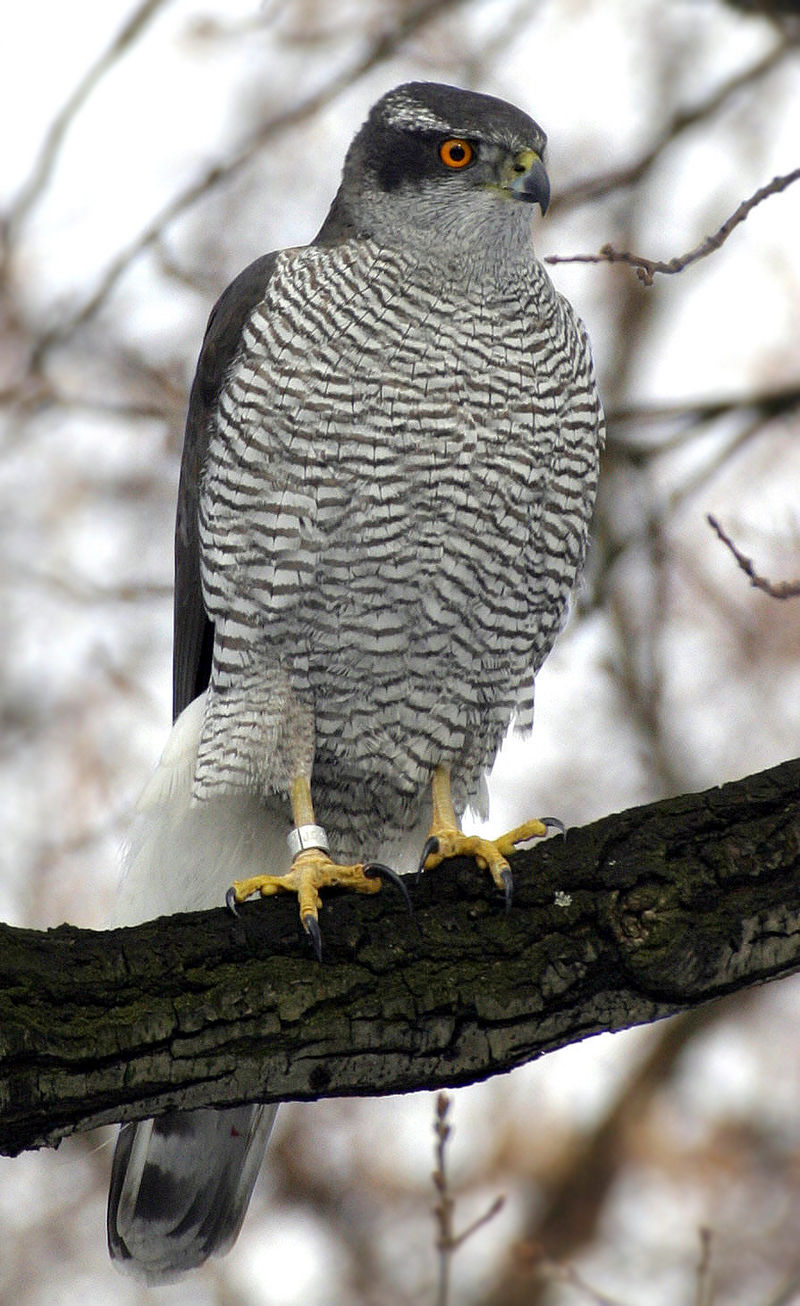
The Northern Goshawk is a medium-large bird of prey belonging to the Accipitridae family. It has been known as one of the true hawks, with “Accipiter” meaning hawk in Latin and “gentilis” referring to its noble characteristics.
They are found worldwide, most commonly in wooded areas such as forests or thickets where they hunt small birds and mammals.
The males have spotted grey upperparts while females tend to be fully brown above with some lighter barring on their underparts.
These raptors rely heavily on speed and agility when hunting from either perches or during aerial dives at high speeds for their prey which makes them formidable predators that can reach up to 40 mph.Scientific classification:
| Kingdom | Animalia |
| Phylum | Chordata |
| Class | Aves |
| Order | Accipitriformes |
| Family | Accipitridae |
| Genus | Accipiter |
| Species | A. gentilis |
Also Featured In: Native Birds Of Germany, Belarus Birds You Should Know
9. Red-Breasted Nuthatch

The Red-breasted Nuthatch is a beautiful and vocal songbird that can be found in coniferous forests across Canada, Alaska, the northeastern United States and western US.
This small bird has blue-grey upperparts with cinnamon underparts, a white throat and face with black eye stripe, straight grey bill and black crown.
Its call sounds like a tin trumpet; it’s high-pitched yet nasal.
During mating season they form monogamous pairs to build their nest near tree trunks or branches at low heights off the ground where they lay 2 – 8 eggs at once.
They are very active little birds who love clinging to trees while searching for insect larvae or seeds within the bark of trees which helps control pest populations.Scientific classification:
| Kingdom | Animalia |
| Phylum | Chordata |
| Class | Aves |
| Order | Passeriformes |
| Family | Sittidae |
| Genus | Sitta |
| Species | S. canadensis |
Also Featured In: Common Birds in Canada, Common Birds in Saskatchewan
10. Song Sparrow

The Song Sparrow (Melospiza melodia) is a small, yet abundant bird found in North America.
They have brown upperparts with dark streaks and are white underneath, complete with a distinct dark brown spot on the breast.
Their cap is also brown and long roughed feathers can be seen sprouting from their neck area.
This sparrow species is highly variable and adaptable to many different environments including dry brush land, wetlands or open fields.
It has been noted that adult song sparrows will sing even during winter months when other birds remain quiet.
These energetic little animals make for great backyard companions as they flit about singing their lovely melodies.Scientific classification:
| Kingdom | Animalia |
| Phylum | Chordata |
| Class | Aves |
| Order | Passeriformes |
| Family | Passerellidae |
| Genus | Melospiza |
| Species | M. melodia |
Also Featured In: Birds that Live in Mississippi, Birds that Live in Vancouver
11. Sandhill Crane
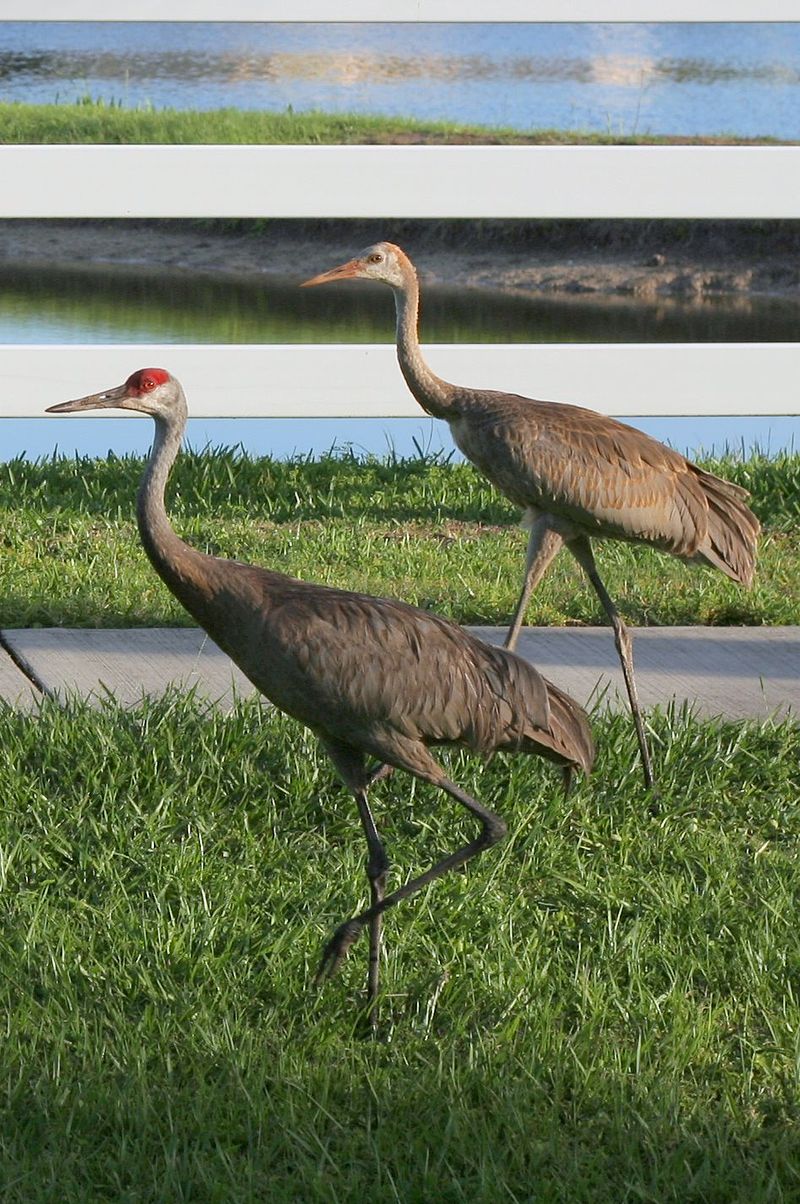
Sandhill Cranes are a large species of crane native to North America and northeastern Siberia. They are known for their distinctive calls, long legs, and long necks.
These birds typically inhabit wetland areas like the Platte River in Nebraska’s Sandhills on the Great Plains.
In Central Florida, they often gather at the edges of bodies of water such as lakes or rivers.
During breeding season, sandhill cranes can be seen performing elaborate courtship dances that involve bowing and jumping in unison with their partner.
Their diet consists mainly of plant material including grains, roots, tubers and aquatic plants which they obtain by pecking or digging into mudflats using their bill or feet respectively.
With an average lifespan between 10-20 years these majestic creatures make great additions to any wetland habitat.Scientific classification:
| Kingdom | Animalia |
| Phylum | Chordata |
| Class | Aves |
| Order | Gruiformes |
| Family | Gruidae |
| Genus | Antigone |
| Species | A. canadensis |
Also Featured In: Most Common Types of Birds Found in Cuba, Flocks Birds around Us
12. Horned Grebe
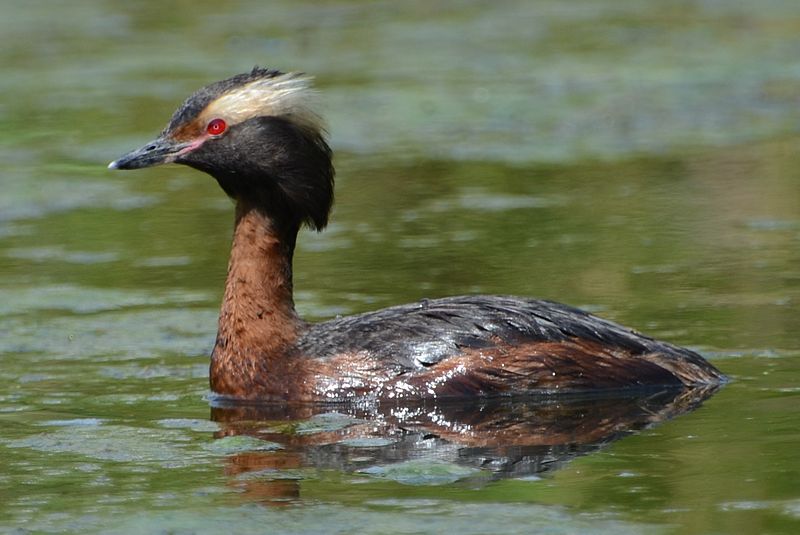
The Horned Grebe is a small aquatic bird that belongs to the family of Podicipedidae. It has two known subspecies: P. auritus, which breeds in Palearctic regions, and P. cornutus which breeds in North America.
The Eurasian subspecies inhabits most parts of northern Europe and the Palearctic from Greenland to western China while its American counterpart can be found across Canada and Alaska down through California and some areas of Mexico’s coasts too.
This species adapts easily to different wetland habitats like lakes, rivers or marshes with abundant vegetation cover for nesting purposes as well as providing protection against predators.
They are excellent divers who feed on fish eggs, insects, mollusks & crustaceans along with plant material such as seeds & grains when available seasonally throughout their range.Scientific classification:
| Kingdom | Animalia |
| Phylum | Chordata |
| Class | Aves |
| Order | Podicipediformes |
| Family | Podicipedidae |
| Genus | Podiceps |
| Species | P. auritus |
Also Featured In: Native Birds Of Libya, Common Estonian Birds
13. Redhead
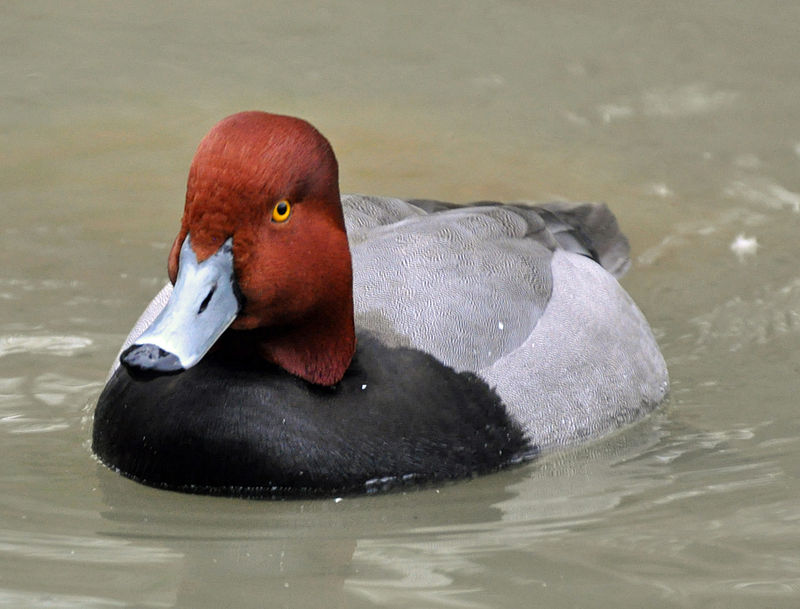
The Redhead is a medium-sized diving duck that can be found in North America. It has a scientific name of Aythya americana, with its Greek roots translating to an unidentified seabird and the Latin meaning “of America”.
This bird measures 37 cm (15 in) long on average with an 84 cm (33 in) wingspan. The typical weight for this species ranges from 2 to 2.5 pounds, although males tend to weigh slightly more than females at around 2.4 lbs (1083 g).
Its beautiful plumage includes shades of browns and grays along with distinctive red feathers on its head which give it its name.
They mainly feed off insects, aquatic plants, small fish and crustaceans making them excellent divers.Scientific classification:
| Kingdom | Animalia |
| Phylum | Chordata |
| Class | Aves |
| Order | Anseriformes |
| Family | Anatidae |
| Genus | Aythya |
| Species | A. americana |
Also Featured In: Bermuda birds, Red Birds You’ll See in Maryland
14. Chestnut-Backed Chickadee
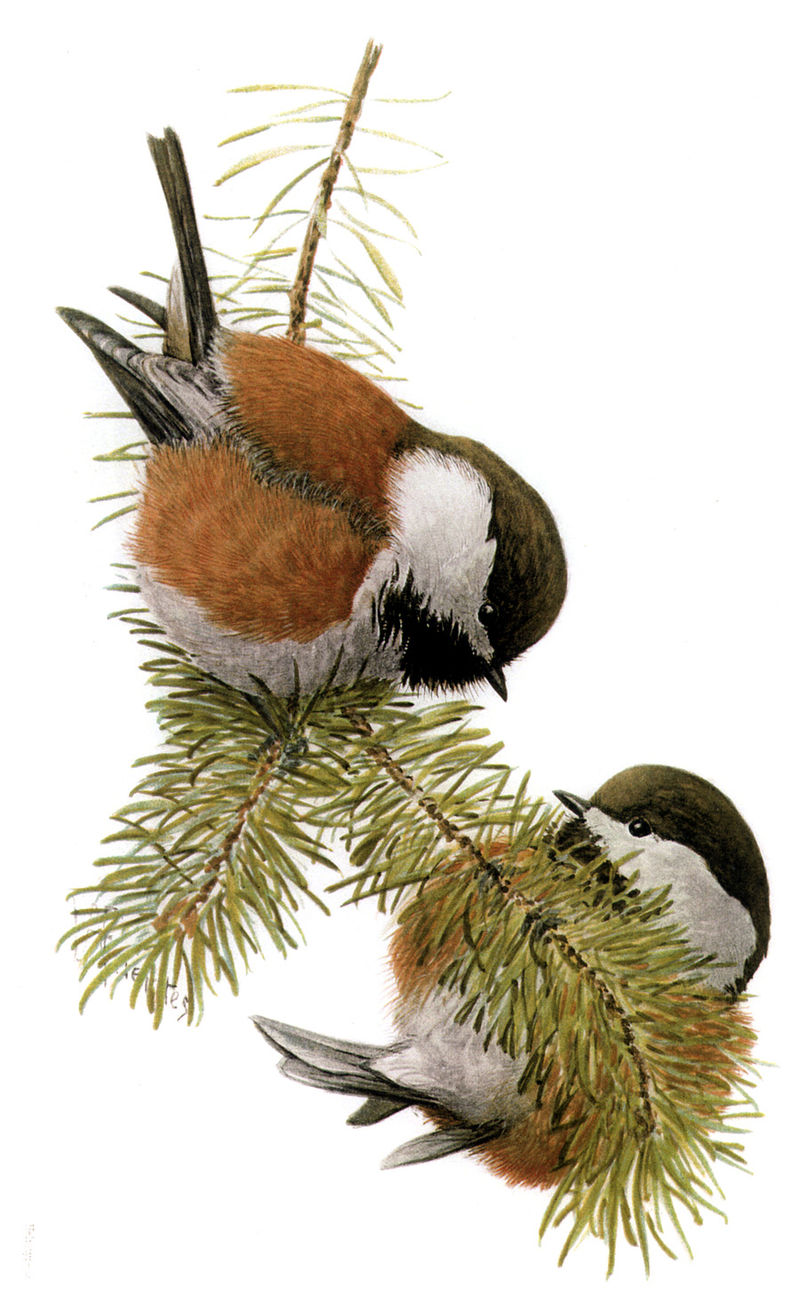
The Chestnut-backed Chickadee is a small passerine bird in the tit family, Paridae. It lives within the Pacific Northwest region of America and Canada; its range extending from southern Alaska to southwestern California.
This species remains a permanent resident throughout its area rather than migrating seasonally, although feeding flocks may temporarily move short distances for food sources.
They are commonly found in woodlands with dense understory vegetation as well as suburban gardens.
The male and female birds can be distinguished by their distinctive patterned plumage: males have brown backs while females are grayer above but both share white bellies and buffy sides striped with black barring across their wings and tails.
These sociable birds usually feed on insects or seeds which they obtain from trees or shrubs using their sharp beaks.Scientific classification:
| Kingdom | Animalia |
| Phylum | Chordata |
| Class | Aves |
| Order | Passeriformes |
| Family | Paridae |
| Genus | Poecile |
| Species | P. rufescens |
Also Featured In: Chickadees Birds, Common Southern Californian Birds
15. Tufted Puffin
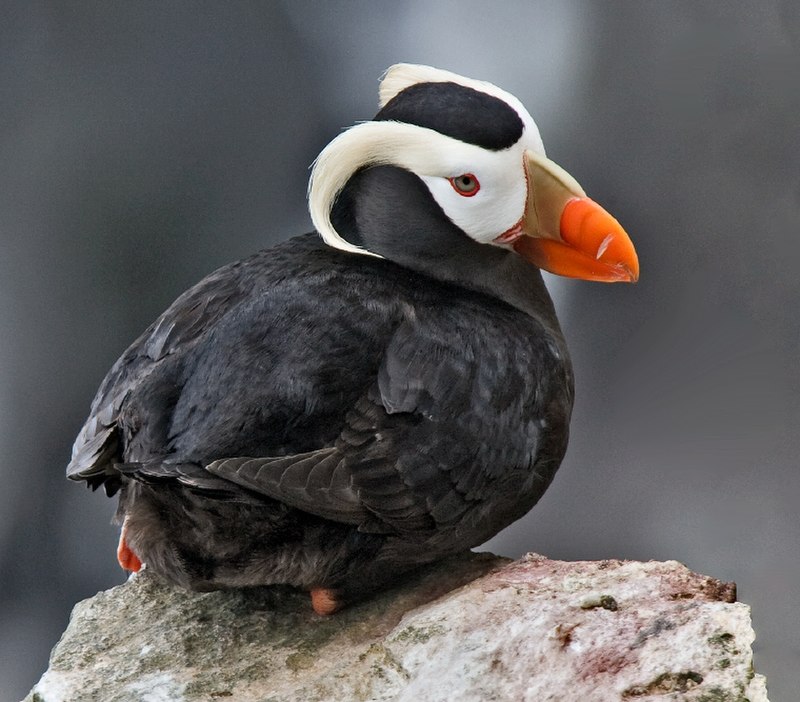
The Tufted Puffin is a medium-sized seabird belonging to the Alcidae family. It can be recognized by its thick red bill and yellow tufts, which give it an unmistakable appearance.
These birds inhabit the North Pacific Ocean and are relatively abundant compared to other species of puffin.
They measure around 35 cm in length with a similar wingspan, making them one of the smaller members of their genus Fratercula.
In terms of feeding habits they mainly eat small fish like herring or anchovies while at sea but also take advantage of food sources near shore when breeding season arrives.
Their eggs are laid in burrows that these feathered creatures dig into cliff faces for protection from predators; once hatched both parents help raise their young until they fledge later on in life.Scientific classification:
| Kingdom | Animalia |
| Phylum | Chordata |
| Class | Aves |
| Order | Charadriiformes |
| Family | Alcidae |
| Genus | Fratercula |
| Species | F. cirrhata |
Also Featured In: Auks Species, Birds You’ll Find in the Sea
16. Bonaparte’s Gull
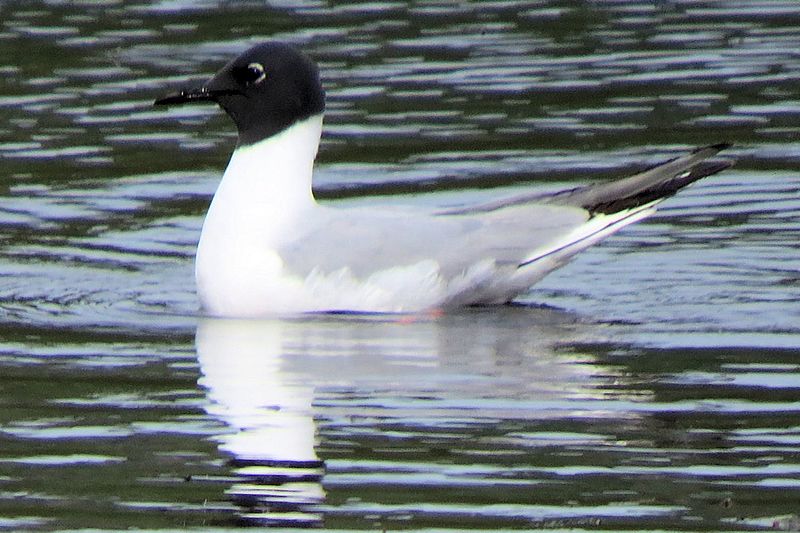
Bonaparte’s gull is a small species of gull usually found in northern North America. It measures 28 to 38 cm (11 to 15 inches) long and has mainly white plumage with grey upperparts.
During breeding season, it develops a slaty-black hood on its head. Both male and female Bonaparte’s gulls look alike; they are not sexually dimorphic like some other birds.
This bird was first described by George Ord in 1818, although Native Americans had likely been familiar with the bird for much longer than that.
Its scientific name Chroicocephalus philadelphia means “grey headed Philadelphia” due to its resemblance to the city’s official bird – the American Bald Eagle.
The bonaparte’s Gull is an active hunter which feeds mostly on insects and invertebrates as well as fish eggs or larvae when available.
Despite their size, these birds can often be seen flying far away from shorelines over open water looking for food.Scientific classification:
| Kingdom | Animalia |
| Phylum | Chordata |
| Class | Aves |
| Order | Charadriiformes |
| Family | Laridae |
| Genus | Chroicocephalus |
| Species | C. philadelphia |
Also Featured In: Gulls Species, Birds of Taiga
17. Rufous Hummingbird
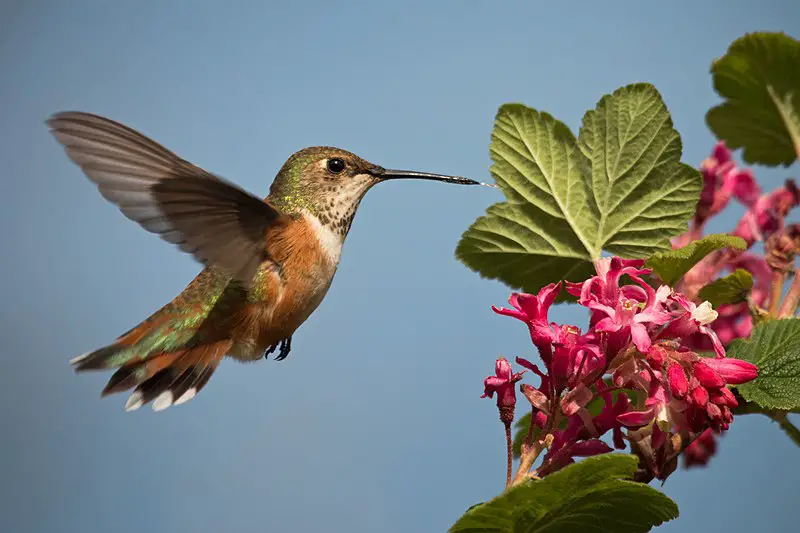
The beautiful Rufous Hummingbird is a small bird of 8 cm in length, with a long slender beak. It stands out due to its extraordinary flight skills and incredible migratory transits- they can fly up to 2,000 miles.
This species was formally described by German naturalist Johann Friedric in 1788 and belongs to the genus Selasphorus.
These birds are found all over North America and parts of Mexico during summertime; while wintering in Central America or northern South America.
They feed on nectar from flowers as well as insects for protein intake. With their vibrant feathers, agile flying abilities and fascinating life cycle they make an interesting addition to any backyard wildlife habitat.Scientific classification:
| Kingdom | Animalia |
| Phylum | Chordata |
| Class | Aves |
| Order | Apodiformes |
| Family | Trochilidae |
| Genus | Selasphorus |
| Species | S. rufus |
Also Featured In: Hummingbirds Species, Birds That Live in Colorado
18. Spotted Owl
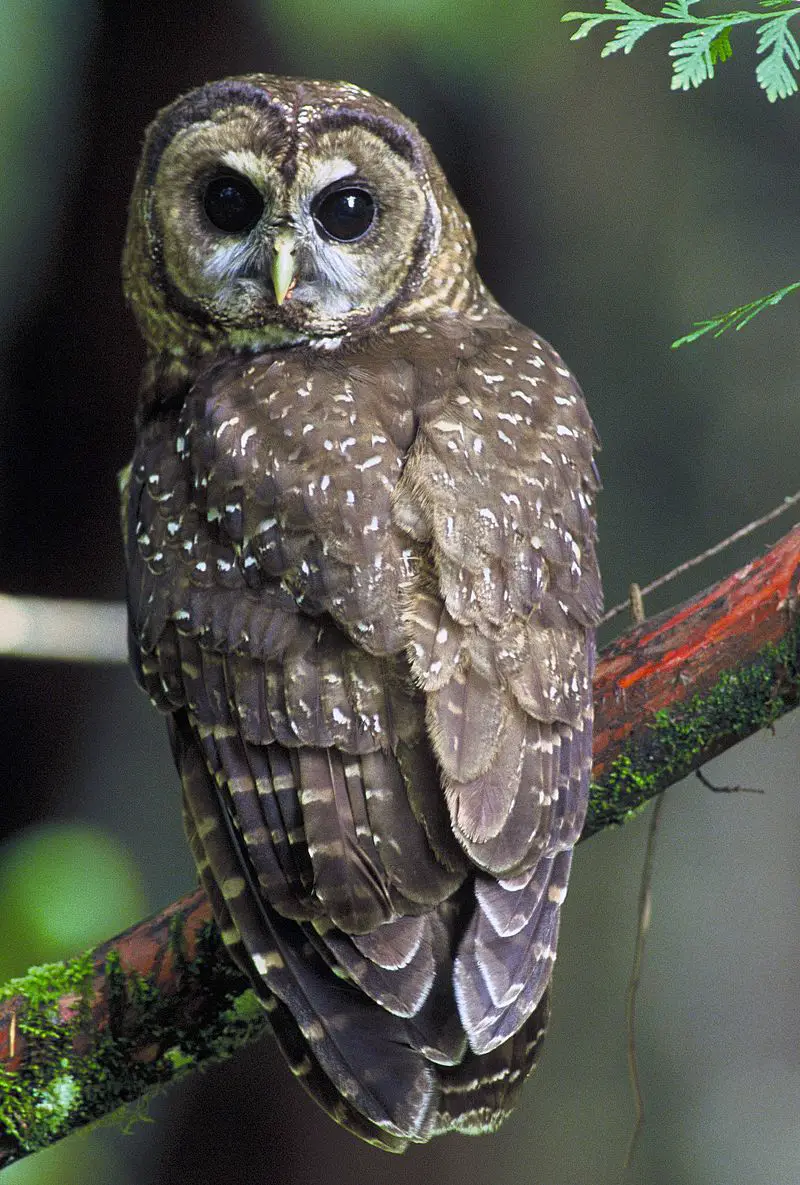
The Spotted Owl is an iconic species of true owl found in old-growth forests across western North America. It is a nocturnal bird that nests up to 60 meters high, typically laying two eggs per nest.
This beautiful creature feeds on small mammals and birds as part of its diet. Its striking plumage has helped make it well known among both amateur ornithologists and professional biologists alike, with the adult being characterized by spotted feathers all over its body along with yellow eyes and a barred tail.
The conservation status for this bird remains vulnerable due to habitat destruction caused by human activities such as logging operations throughout its range.
As such, the protection of these areas from further disturbance is critical for the survival of this species into future generations.Scientific classification:
| Kingdom | Animalia |
| Phylum | Chordata |
| Class | Aves |
| Order | Strigiformes |
| Family | Strigidae |
| Genus | Strix |
| Species | S. occidentalis |
Also Featured In: Owls Species,
19. White-Crowned Sparrow
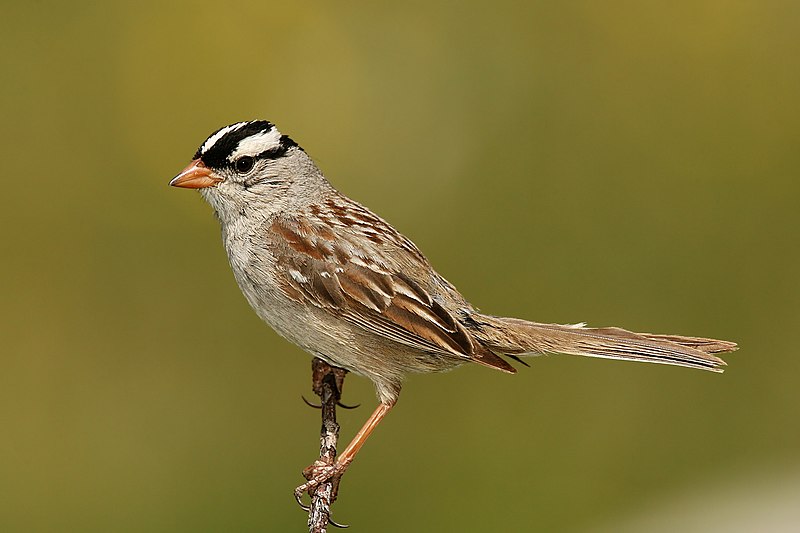
The White-crowned Sparrow is a species of passerine bird native to North America. It has a grey face and black and white streaking on its upper head, making it easy to identify.
This sparrow usually breeds in brushy areas located in the taiga, tundra, Rocky Mountains or Pacific coast regions of North America.
During winter months these birds migrate southward as far as Mexico and California where they can be found living amongst chaparral shrubbery or low bushes near open fields with plenty of seeds nearby.
The diet of this bird consists mainly of insects during summer while they switch over to eating grains like wheat & oats during colder months when bugs are scarce.
They are known for their characteristic chirp which sounds like “Oh sweet Canada Canada” drawing admirers from around the world.Scientific classification:
| Kingdom | Animalia |
| Phylum | Chordata |
| Class | Aves |
| Order | Passeriformes |
| Family | Passerellidae |
| Genus | Zonotrichia |
| Species | Z. leucophrys |
Also Featured In: Sparrows Species, Most Common Songs Birds that Live around You
20. Lincoln’s Sparrow
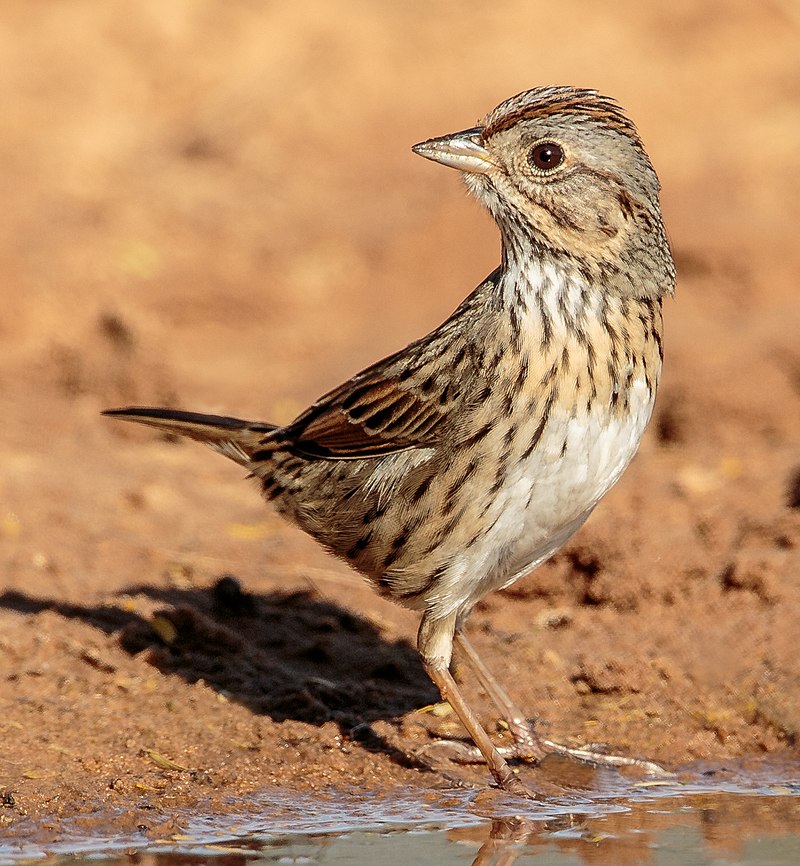
Lincoln’s sparrow is a small passerine bird native to North America. It has brown upperparts, white underparts and a distinctive light-gray eyebrow line above its eyes.
The species usually stays hidden in thick ground cover but can be identified by its sweet, wrenlike song.
Lincoln’s sparrow belongs to the genus Melospiza along with two other species: the Song Sparrow (M.melodia) and Swamp Sparrow (M. georgiana).
This elusive yet beautiful bird inhabits well-covered areas such as wetlands, grasslands, shrubland valleys, pastures and open woodlands across most of Canada and parts of northern USA throughout summer months before migrating south for winter season.Scientific classification:
| Kingdom | Animalia |
| Phylum | Chordata |
| Class | Aves |
| Order | Passeriformes |
| Family | Passerellidae |
| Genus | Melospiza |
| Species | M. lincolnii |
Also Featured In: Birds You’ll Find in South Texas , Birds that Live in the Grasslands
21. Golden-Crowned Sparrow
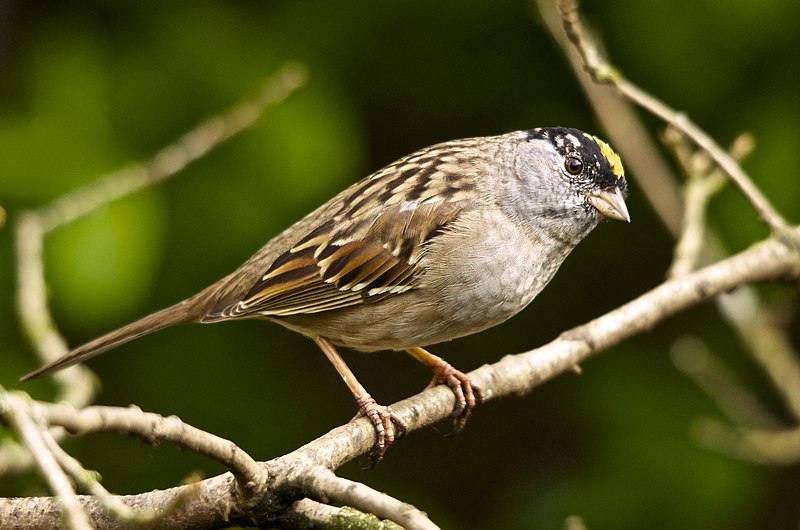
The golden-crowned sparrow is a large New World bird found in the western part of North America. It belongs to the genus Zonotrichia, made up of five species and has no subspecies.
This bird is closely related to the white-crowned sparrow as studies show their mitochondrial DNA evolves at a similar rate.
The most recognizable feature on this beautiful creature are its distinctive yellow stripes near its forehead that appear almost like an orange crown when seen from afar.
Its plumage can range from grey browns in winter months, to dull yellows and oranges during breeding season which typically occurs between April and July.
These birds are often seen foraging through leaf litter or along grassy fields looking for seeds, insects and berries to eat while they sing sweet melodies throughout their habitat.Scientific classification:
| Kingdom | Animalia |
| Phylum | Chordata |
| Class | Aves |
| Order | Passeriformes |
| Family | Passerellidae |
| Genus | Zonotrichia |
| Species | Z. atricapilla |
Also Featured In: Birds That Live around Seattle, Birds that Live in San Francisco Bay Area
22. Violet-Green Swallow
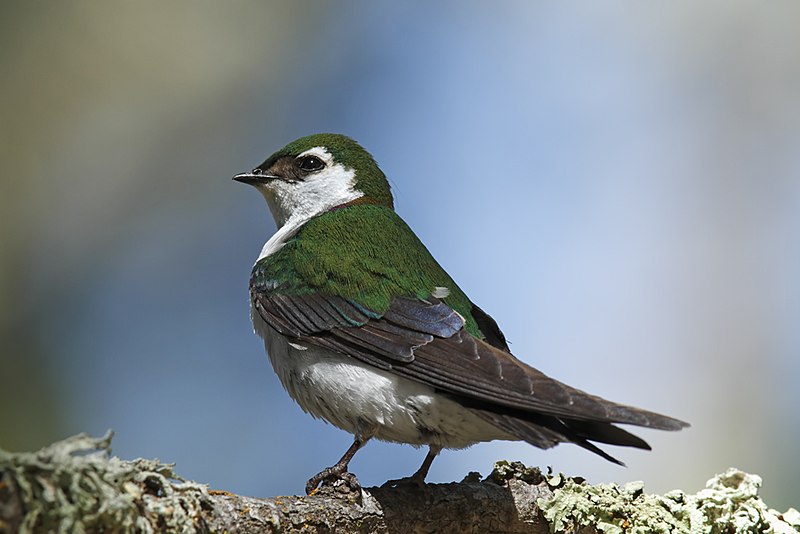
The Violet-green Swallow is a small, North American passerine bird belonging to the swallow family.
These birds are known for their aerial insectivorous diet and beautiful green coloration with white rump side patches that appear as if they’re separating it from other swallows.
They inhabit areas along the west coast of America, ranging from Alaska all the way down to Mexico and also extending eastwards to Montana and Texas.
This species can be seen swooping through open air in search of food or heard chirping away during its mating season – usually occurring between April till late summer months.
It’s an important part of many ecosystems due to its role in controlling insects populations.Scientific classification:
| Kingdom | Animalia |
| Phylum | Chordata |
| Class | Aves |
| Order | Passeriformes |
| Family | Hirundinidae |
| Genus | Tachycineta |
| Species | T. thalassina |
Also Featured In: Swallows Species, House Birds You’ll Love to Pet
23. Hermit Thrush
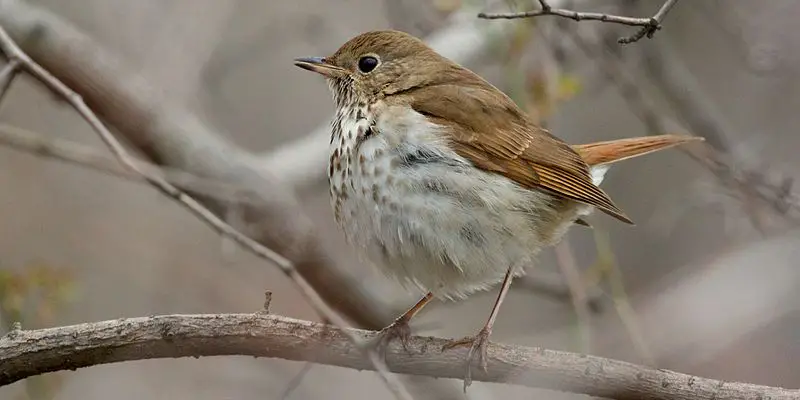
The Hermit Thrush is a medium-sized bird native to North America. It is easily identified by its spotted feathers and measures between 15-18 cm in length, with wingspan of 25-30 cm across.
This species has an unmistakable sweet song which can be heard during the spring and summer months throughout its range.
They feed on invertebrates such as insects, spiders, worms, snails and berries when available seasonally.
The habitat of this thrush includes deciduous woodlands or thickets near streams or wetlands where they are known to nest high up in trees making them difficult to observe directly but their beautiful songs can often be heard from afar.Scientific classification:
| Kingdom | Animalia |
| Phylum | Chordata |
| Class | Aves |
| Order | Passeriformes |
| Family | Turdidae |
| Genus | Catharus |
| Species | C. guttatus |
Also Featured In: Thrush Species, Birds You’ll Find in Vancouver Island
24. Swainson’s Thrush
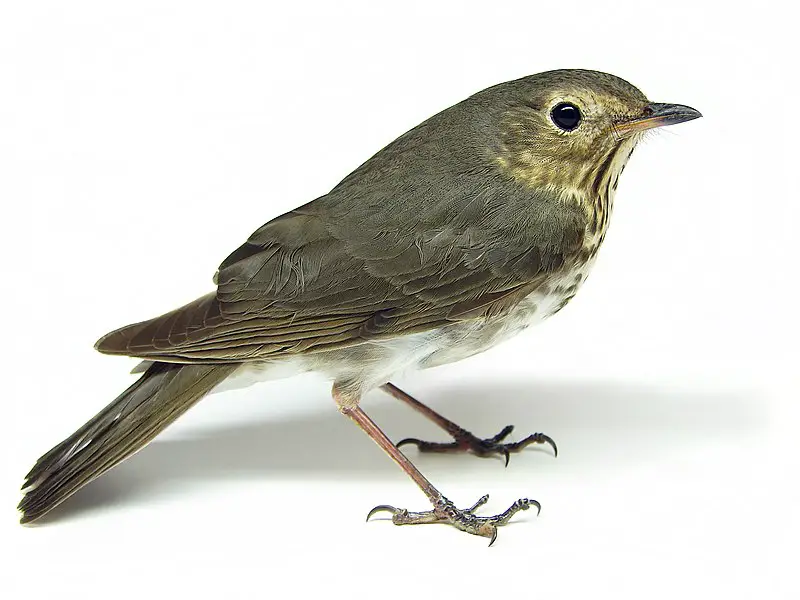
Swainson’s thrush is a medium-sized bird that belongs to the Catharus genus. Its coloration is subdued and its voice has been described as being flute-like, making it an appealing addition to any backyard.
It was named after William Swainson, an English ornithologist from the 19th century. The name of this species comes from Ancient Greek katharos which means “pure” or “clean” – appropriate for such a beautiful creature.
This type of thrush can be found throughout North America in habitats ranging from coniferous forests to open fields with scattered trees and shrubs; they also migrate south during winter months.
Despite their beauty, these birds are declining due to habitat loss and fragmentation so we must work together if we want them around forever.Scientific classification:
| Kingdom | Animalia |
| Phylum | Chordata |
| Class | Aves |
| Order | Passeriformes |
| Family | Turdidae |
| Genus | Catharus |
| Species | C. ustulatus |
Also Featured In: Common Birds in the Cities, North Carolina Mountain Birds
25. Varied Thrush
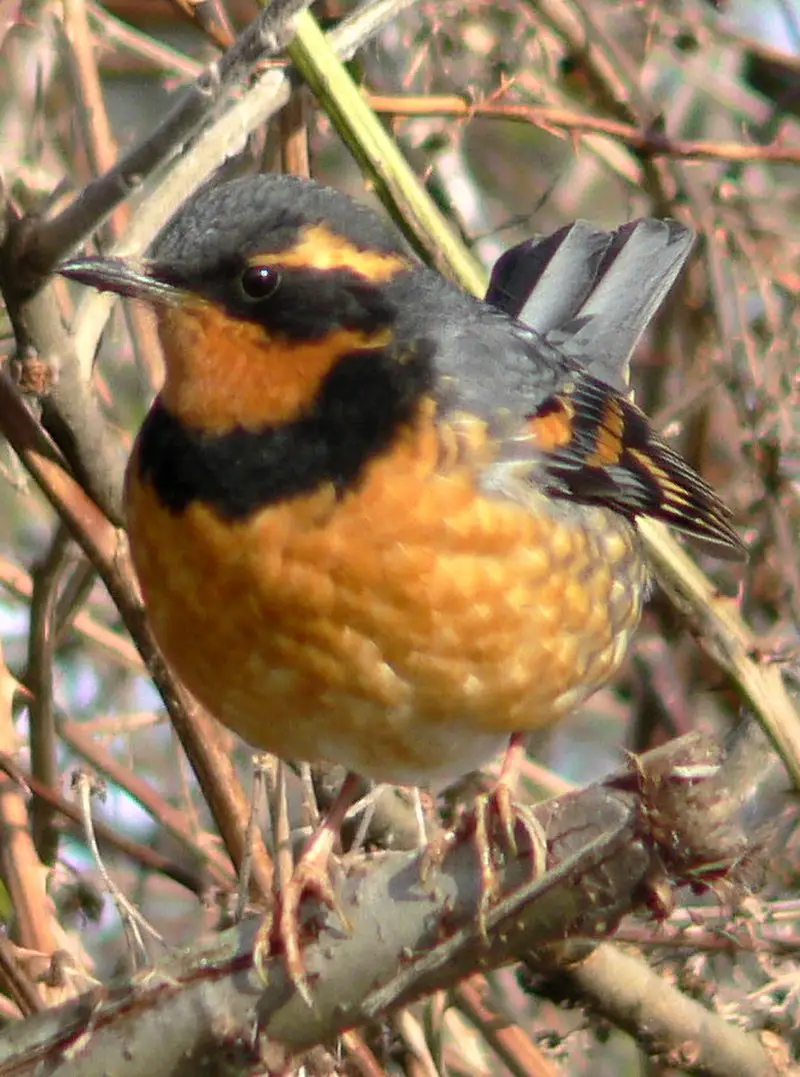
The Varied Thrush (Ixoreus naevius) is the only species in its genus and belongs to the thrush family, Turdidae.
It was first described by German naturalist Johann Friedrich Gmelin in 1789 as Turdus naevius , based on a specimen owned by John Latham which had been described as “Spotted Thrush” four years earlier.
This bird has an olive-brown back with reddish streaks along white underparts; it also bears spots of yellow or orange colouring across its chest.
Its wings are black with bold white patches while its tail appears long and pointed at times when spread out during flight.
The varied thrush can be found throughout western North America from Alaska southwards into California, Arizona, New Mexico and northern Mexico where they prefer habitats such as coniferous forests and mountain areas near streams or rivers for their habitat.
They feed mainly on insects but will also eat fruits if available making them omnivorous birds.Scientific classification:
| Kingdom | Animalia |
| Phylum | Chordata |
| Class | Aves |
| Order | Passeriformes |
| Family | Turdidae |
| Genus | Ixoreus Bonaparte, 1854 |
| Species | I. naevius |
Also Featured In: Autumn Birds You Should Know, Blue Birds that Live around Colorado
26. Red-Breasted Sapsucker
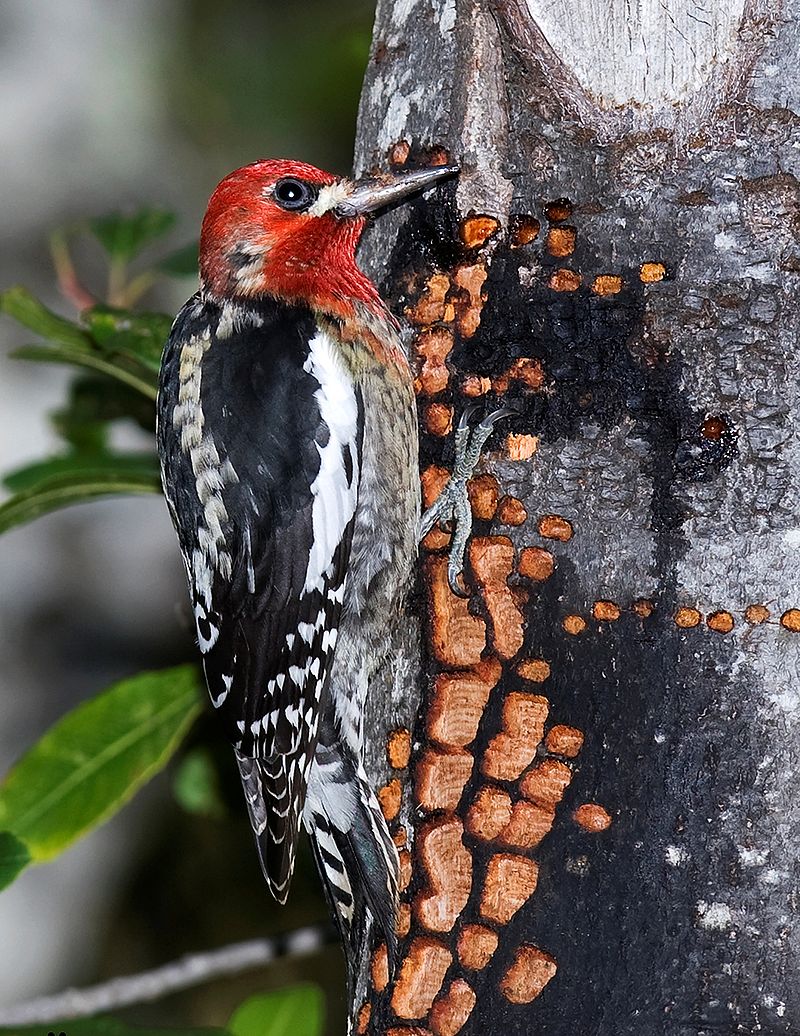
The red-breasted sapsucker is a medium-sized woodpecker native to the forests of the west coast of North America.
It has a striking appearance with its bright red head and upper chest, white lower belly, black back and wings with bars and large white wing patch.
These birds nest in tree cavities during mating season while northern specimens migrate south for winter months.
They are often seen tapping on trees to drill holes into them in order to feed on sap or bark insects that live beneath it.
Additionally, they have been observed feeding from birdfeeders which makes them great additions to backyard bird watching activities.
Overall, the red-breasted sapsucker is an interesting species worth discovering.Scientific classification:
| Kingdom | Animalia |
| Phylum | Chordata |
| Class | Aves |
| Order | Piciformes |
| Family | Picidae |
| Genus | Sphyrapicus |
| Species | S. ruber |
Also Featured In: Woodpeckers Species, Birds that Live in the Grand Canyon National Park
27. Golden-Crowned Kinglet
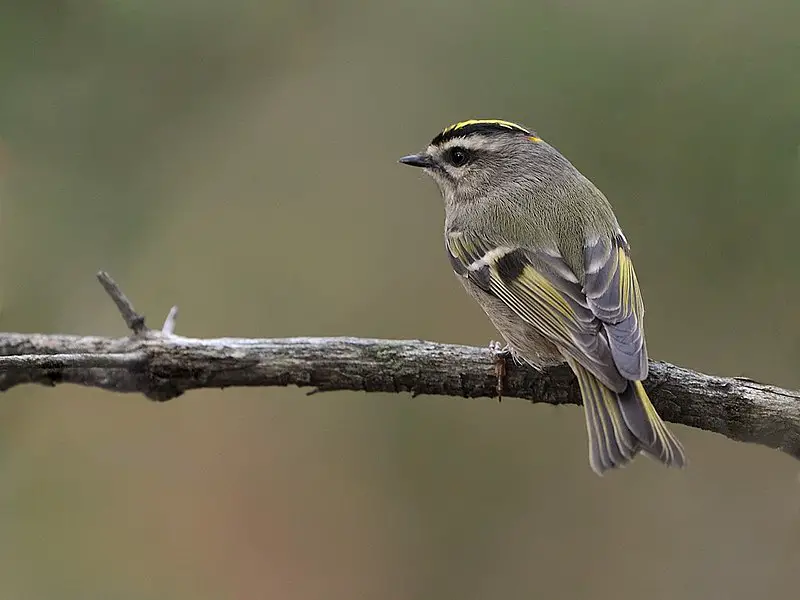
The Golden-crowned Kinglet is a small songbird native to North America. It has an olive-gray top and white underparts, with thin bills and short tails.
The most distinguishing feature of this bird is its yellow crown, surrounded by a black patch that extends through the eyes.
Males have an additional orange patch in the middle of their yellow crowns. They are active birds, often seen flitting from branch to branch as they search for insects or other food sources in trees or shrubs.
During winter months when there’s less insect prey available, Golden-crowned Kinglets will join mixed species flocks searching for berries on bushes and trees throughout forests across North America.Scientific classification:
| Kingdom | Animalia |
| Phylum | Chordata |
| Class | Aves |
| Order | Passeriformes |
| Family | Regulidae |
| Genus | Regulus |
| Species | R. satrapa |
Also Featured In: Wrens Species, Most Common Winter Birds
28. California Scrub Jay
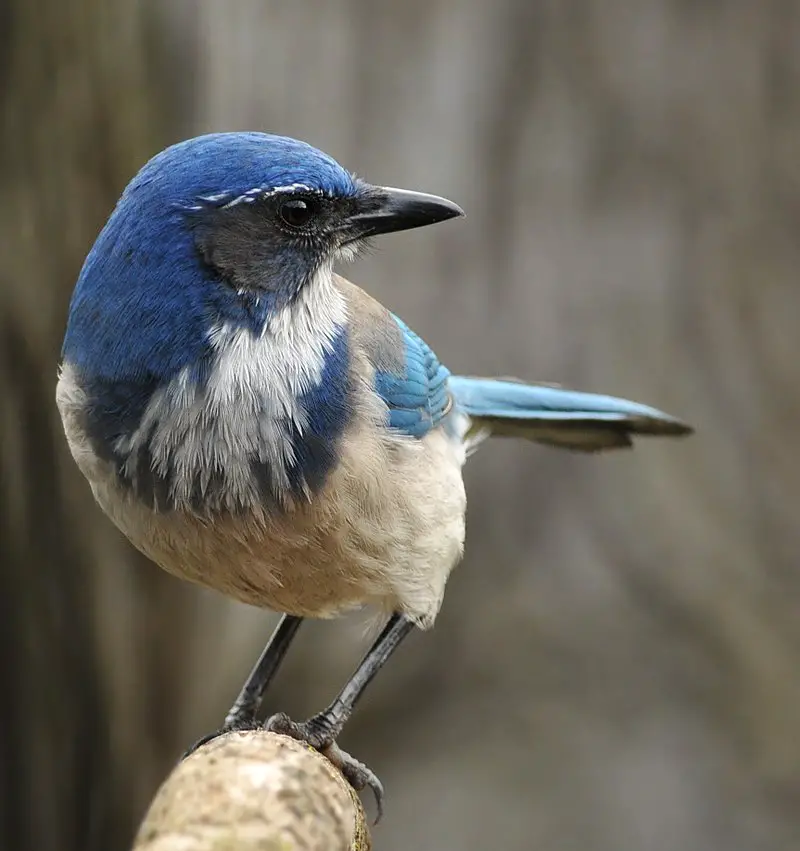
The California scrub jay is a species of bird native to western North America. It can be found from southern British Columbia all the way down through California and western Nevada near Reno, up to west beyond the Sierra Nevada range.
This beautiful blue feathered bird was once categorized with Woodhouse’s scrub jay as the “western scrub jay” along with island scrub jays.
The California Scrub Jay has distinctive features such as its greyish-blue feathers on its head, wings and tail; white cheeks; dark bill; and strong legs for perching in trees which makes it stand out among other birds in its family.Scientific classification:
| Kingdom | Animalia |
| Phylum | Chordata |
| Class | Aves |
| Order | Passeriformes |
| Family | Corvidae |
| Genus | Aphelocoma |
| Species | A. californica |
Also Featured In: Common Californian Birds, Blue Birds You’ll Found around Us
29. Orange-Crowned Warbler
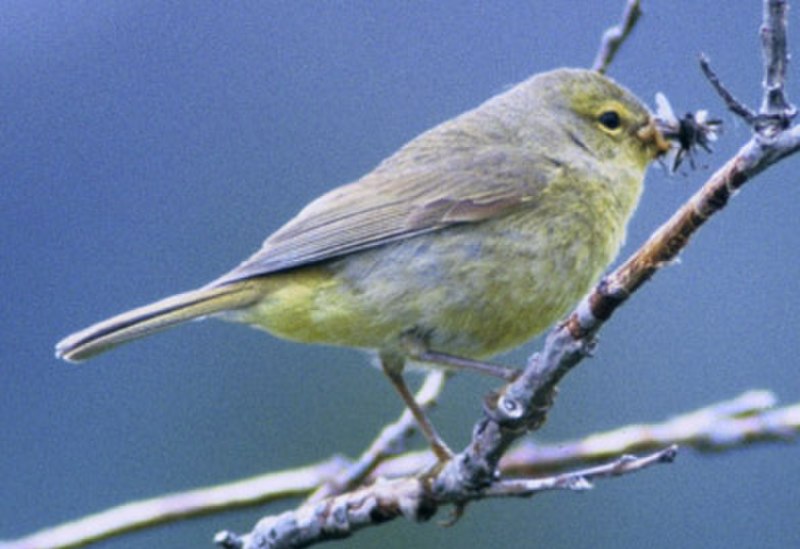
The Orange-crowned Warbler is a small songbird from the New World warbler family. It was formally described in 1822 by Thomas Say, who gave it its scientific name Sylvia celatus – Latin for ‘cloaked’.
This species has an olive green back and wings with yellowish underparts. The males have bright orange crowns during breeding season, which give this bird its namesake.
They can be found mainly in North America but they also migrate to Central America during winter months.
Their diet consists of insects such as butterflies, moths, grasshoppers and beetles; they may also consume fruits occasionally when available.
These birds are relatively quiet except for their mating calls which include whistles or buzzing sounds that last a few seconds long each time.
The Orange-crowned Warbler is one of the most wide spread passerines today due to their hardiness and adaptability; however there remains threat of habitat destruction that could affect many populations negatively if not addressed soon enough.Scientific classification:
| Kingdom | Animalia |
| Phylum | Chordata |
| Class | Aves |
| Order | Passeriformes |
| Family | Parulidae |
| Genus | Leiothlypis |
| Species | L. celata |
Also Featured In: Texas Birds, Phoenix Birds You Should Know
30. Steller’s Jay
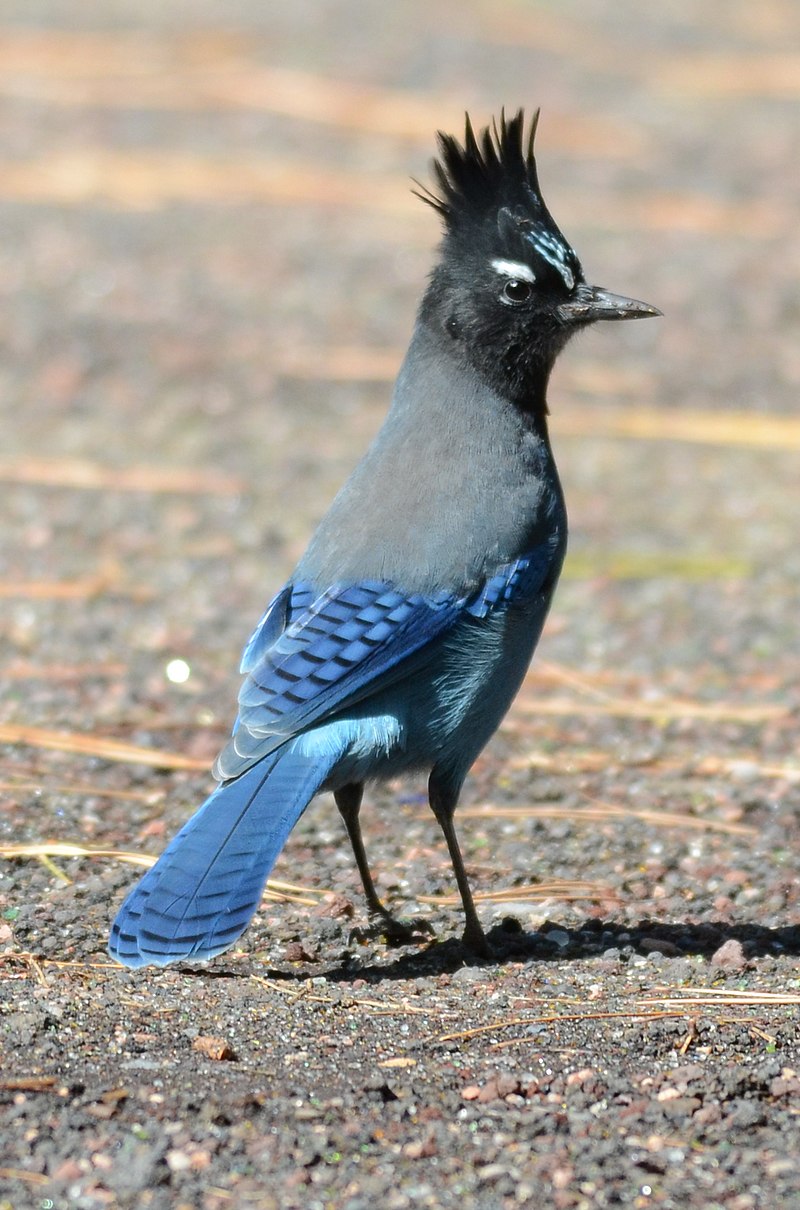
Steller’s jay is a beautiful and colorful bird native to western North America and the mountains of Central America.
It has a distinctive long crest that sets it apart from other birds, with its blue feathers streaked with black, white, gray, and brown markings.
This species is closely related to the blue jays found in eastern North America but can be distinguished by their longer crests.
They are known for being highly vocal birds who like to make loud calls throughout forests they inhabit as well as stealing food from unsuspecting mammals or raiding bird feeders when given the chance.
Steller’s Jays have adapted well to human presence in areas they populate making them great backyard visitors if you’re lucky enough.Scientific classification:
| Kingdom | Animalia |
| Phylum | Chordata |
| Class | Aves |
| Order | Passeriformes |
| Family | Corvidae |
| Genus | Cyanocitta |
| Species | C. stelleri |
Also Featured In: Alaska Birds, Birds that Live in Yosemite National Park
31. Hooded Merganser
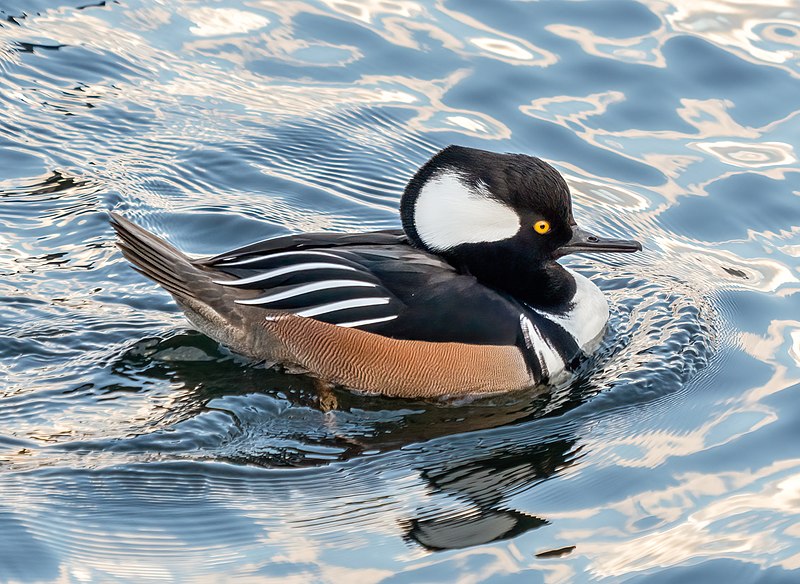
The Hooded Merganser is a beautiful and unique bird, belonging to the family of mergansers. It is easily recognizable due to its distinct crest which can be raised or lowered at will.
During breeding season, males have an impressive plumage with various colors and patterns that make them stand out even more.
They live near streams, ponds or marshes where they feed on aquatic insects, crustaceans and small fish by diving in from above the water surface with their wings open before submerging completely under it.
Their nesting habits involve using hollows created by other animals such as beavers for laying eggs inside tree cavities too close to water bodies so that they are well-protected from predators while still providing them easy access to food sources.Scientific classification:
| Kingdom | Animalia |
| Phylum | Chordata |
| Class | Aves |
| Order | Anseriformes |
| Family | Anatidae |
| Genus | Lophodytes Reichenbach, 1853 |
| Species | L. cucullatus |
Also Featured In: birds of New Mexico, Water Birds Live around Us
32. Short-Billed Dowitcher
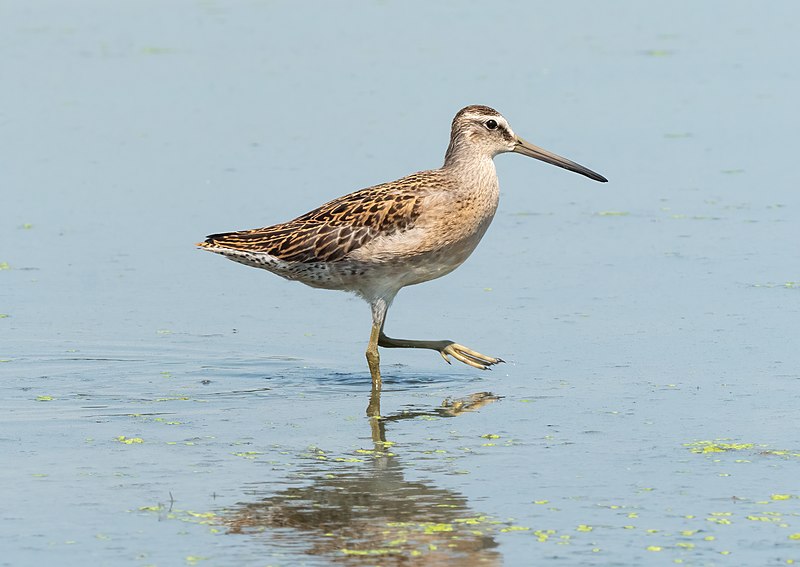
The Short-billed Dowitcher is a medium sized bird belonging to the family Scolopacidae. It has a stocky body and long bill, making it easy to identify in its habitat of North America, Central America, Caribbean and northern South America.
Its strong migratory nature takes them away from their breeding grounds during winter months when snow covers these areas.
This species prefers varied habitats like mudflats and estuaries where they can feed on worms or other invertebrates found there with ease due to their long bills.
During summer they are often seen gathering around wetlands in large flocks which provide protection against predators while also providing an opportunity for breeding activities among them.Scientific classification:
| Kingdom | Animalia |
| Phylum | Chordata |
| Class | Aves |
| Order | Charadriiformes |
| Family | Scolopacidae |
| Genus | Limnodromus |
| Species | L. griseus |
Also Featured In: birds of Mississippi, Winged Marvels of St Martin’s: A Bird Enthusiast’s Delight
33. Townsend’s Warbler
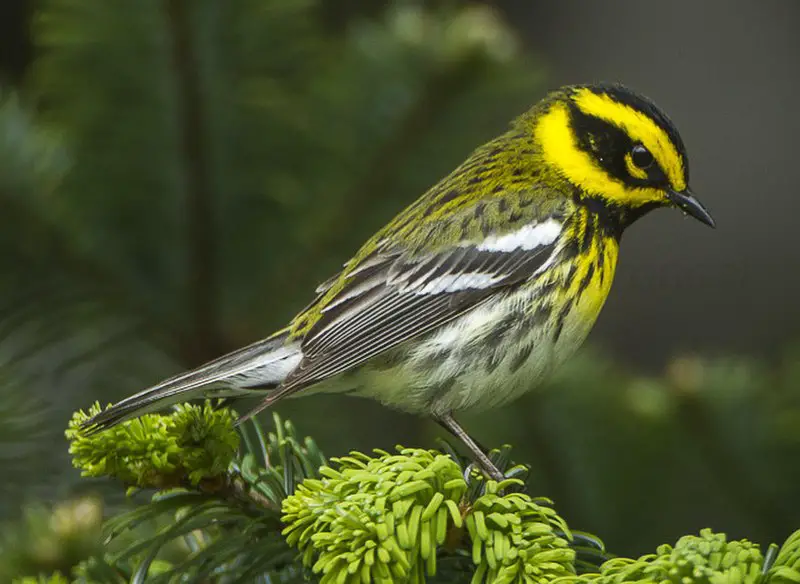
Townsend’s warbler is a stunning bird of the New World Warbler family. It was first described in 1837 by American naturalist John Kirk Townsend, with its type locality being Fort Vancouver on the Columbia River in Washington.
Its appearance and behavior are what make it so special – this small songbird has bright yellow plumage on its head, throat and chest that stands out brilliantly against an olive-green back and wings.
During nesting season they have been known to construct their nests using lichens or mosses woven into intricate cup shapes secured tightly to thin branches.
This species also engages in social behaviors such as chasing other birds away from territories, flocking together when migrating south for winter months, or gathering around water sources like ponds or streams.
Despite their beauty though they remain elusive creatures; often hiding deep within dense foliage making it difficult to observe them up close.Scientific classification:
| Kingdom | Animalia |
| Phylum | Chordata |
| Class | Aves |
| Order | Passeriformes |
| Family | Parulidae |
| Genus | Setophaga |
| Species | S. townsendi |
Also Featured In: birds of yellow birds, Common Yellow Birds of Idaho
34. Brown Pelican

The majestic brown pelican is a dive-feeding bird that belongs to the pelican family. It is one of the three pelican species found in the Americas and is known to dive into water to catch its prey.
From the Atlantic Coast of New Jersey to the mouth of the Amazon River, and along the Pacific Coast from British Columbia to northern Chile, including the Galapagos Islands, this bird can be found.
Its scientific name is Pelecanus occidentalis, and it has a colored brown plumage, which is its distinct characteristic.
The brown pelican belongs to the largest bird species that exist today, with a wingspan that can stretch up to seven feet long.
This bird helps maintain a balance in the ecosystem by eating smaller fish, crustaceans, and other aquatic prey.Scientific classification:
| Kingdom | Animalia |
| Phylum | Chordata |
| Class | Aves |
| Order | Pelecaniformes |
| Family | Pelecanidae |
| Genus | Pelecanus |
| Species | P. occidentalis |
Also Featured In: Flight Birds You Should Know, Galapagos Birds You Should Know
35. Cedar Waxwing
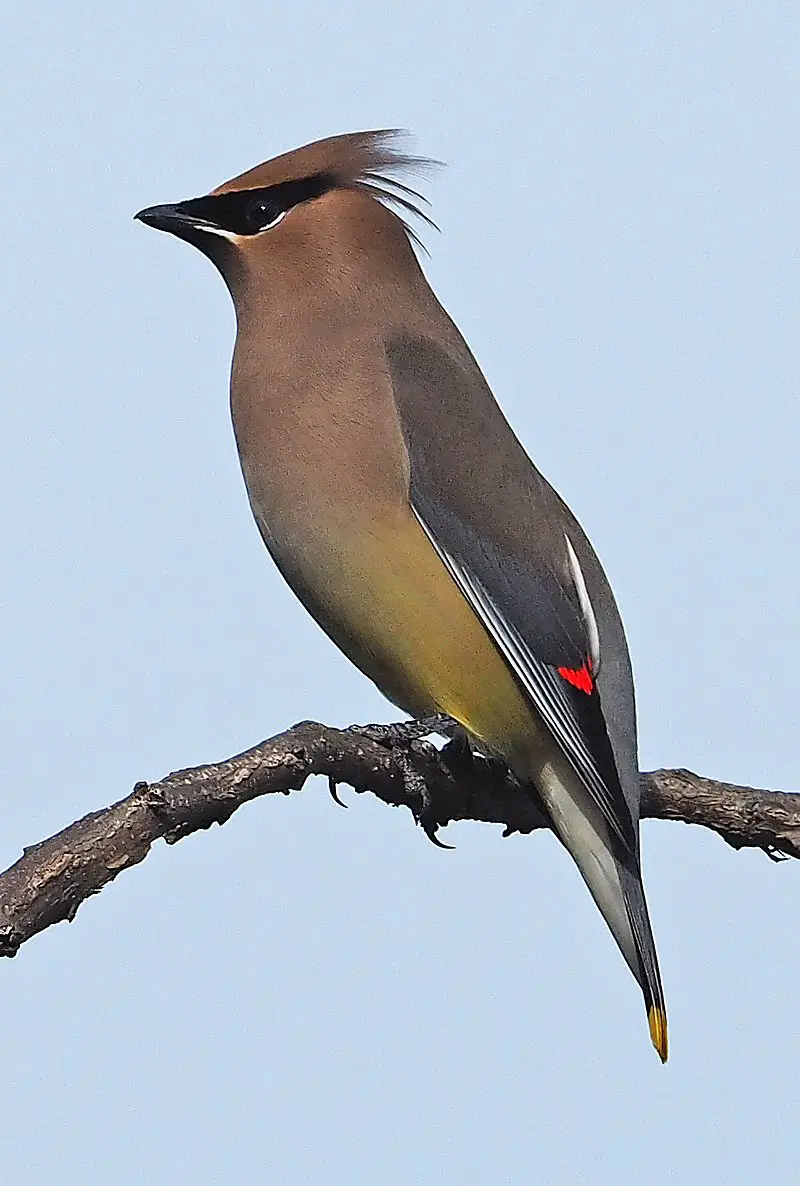
The Cedar waxwing, also known as Bombycilla cedrorum, is a medium-sized bird found in North and Central America.
They have a mixture of brown, gray and yellow feathers on their body, and their wings have wax-like tips.
These birds prefer open wooded areas in Southern Canada for breeding, and during winter, they migrate to the Southern part of the United States, Central America, and the far.
The Cedar waxwing is a member of the waxwing family of birds or Bombycillidae family.
They are known for their distinctive crest on their head and a black mask-like area around their eyes.
These birds are social creatures and can often be seen in large flocks, sometimes even intermixing with other bird species.
Their diet consists mainly of fruit and insects, and they are important dispersers of fruit seeds.
The Cedar waxwing bird is a beautiful and fascinating creature to observe in the wild.Scientific classification:
| Kingdom | Animalia |
| Phylum | Chordata |
| Class | Aves |
| Order | Passeriformes |
| Family | Bombycillidae |
| Genus | Bombycilla |
| Species | B. cedrorum |
Also Featured In: Birds Commonly Found in New York, Birds Live in Arkansas
36. Lesser Scaup
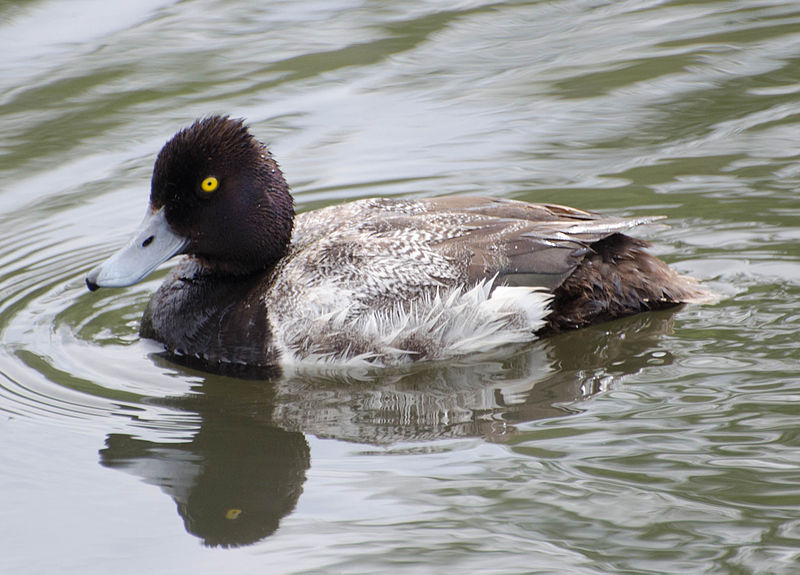
The Lesser scaup is a type of small diving duck that can be found in North America. In the winter months, these ducks migrate to Central America.
Their most remarkable feature is their blue bill, which has earned them colloquial names such as “little bluebill” and “broadbill.”
While it is unclear where their name “scaup” comes from, it is thought to originate from their preferred food source of scalp, a Scottish term for mollusks.
Despite being small in size, these ducks are skilled divers and can remain underwater for up to thirty seconds.
The Lesser scaup is an important species to the ecosystem, as they help to control the population of their prey species while providing food for predators in the area.Scientific classification:
| Kingdom | Animalia |
| Phylum | Chordata |
| Class | Aves |
| Order | Anseriformes |
| Family | Anatidae |
| Genus | Aythya |
| Species | A. affinis |
Also Featured In: Most Common Lake Birds, Common Birds Found near Robert Island
37. Least Sandpiper
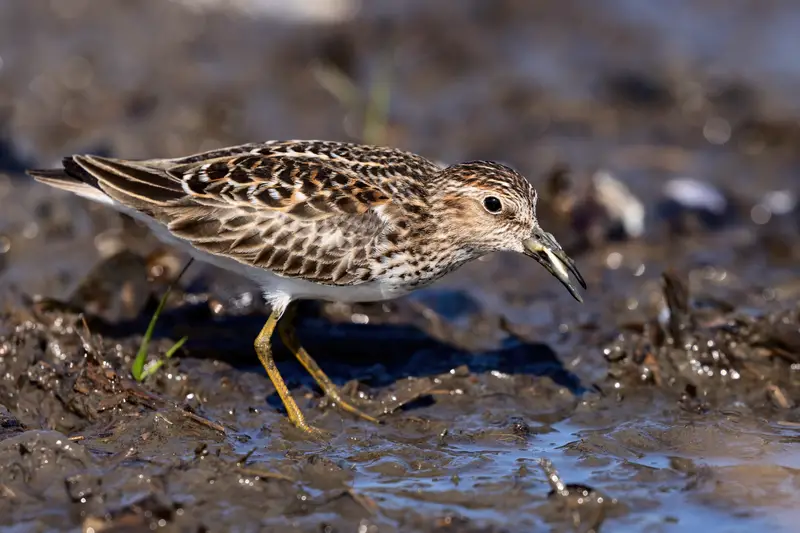
The Least Sandpiper is a shorebird that holds the title for being the smallest of its kind. Its Ancient Greek genus name, kalidris or skalidris, referred to grey-colored waterside birds.
The breed’s brown feathers with dark brown streaks, white underside, greenish legs, and short, thin, dark bill characterize adult Least Sandpipers.
The Medieval Latin name of the species, minutilla, further describes the breed’s tiny size.
These birds are known to inhabit shallow water marshes and mudflats during the summertime, and they migrate to coasts during the winters.
Least Sandpipers mainly feed on insects and small crustaceans, often by running and pecking in shallow water or mud.
Despite their small size, these birds travel great distances during migration, making impressive journeys from their breeding and wintering grounds.Scientific classification:
| Kingdom | Animalia |
| Phylum | Chordata |
| Class | Aves |
| Order | Charadriiformes |
| Family | Scolopacidae |
| Genus | Calidris |
| Species | C. minutilla |
Also Featured In: Caribbean Birds, Most Common Oaxaca Birds
38. Western Sandpiper
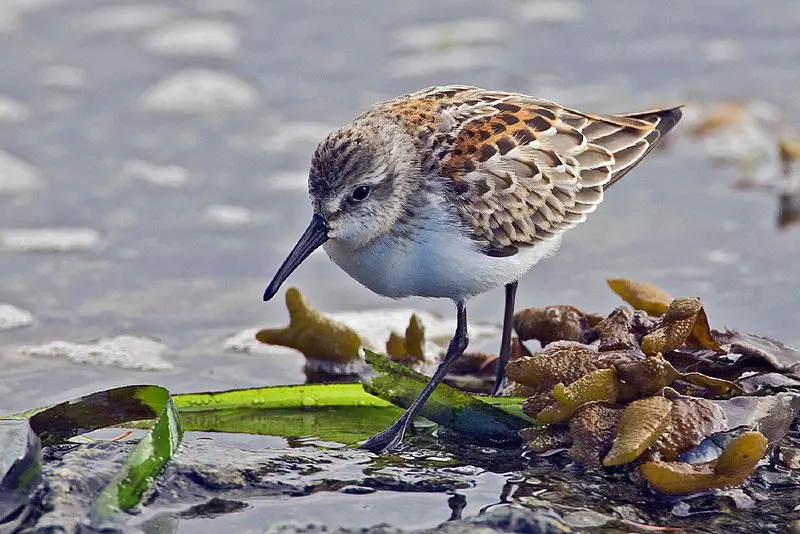
The Western sandpiper is a small shorebird found in North America. Its genus name, Kalidris, comes from the Ancient Greek term used by Aristotle for some grey-colored waterside birds.
The species name, mauri, is named after Italian botanist Ernesto Mauri. This species is one of the most abundant shorebirds in North America, with a population in the millions. Western sandpipers have dark legs and a short, straight bill.
They are often seen running quickly along the shorelines, probing the sand for insects and small crustaceans.
During breeding season, they nest in the Arctic tundra, and during migration, they can be found on mudflats and beaches along the Pacific Coast as well as inland shallow freshwater wetlands.Scientific classification:
| Kingdom | Animalia |
| Phylum | Chordata |
| Class | Aves |
| Order | Charadriiformes |
| Family | Scolopacidae |
| Genus | Calidris |
| Species | C. mauri |
Also Featured In: Estuaries Birds, Birds that Live in Tabasco
39. Northern Spotted Owl
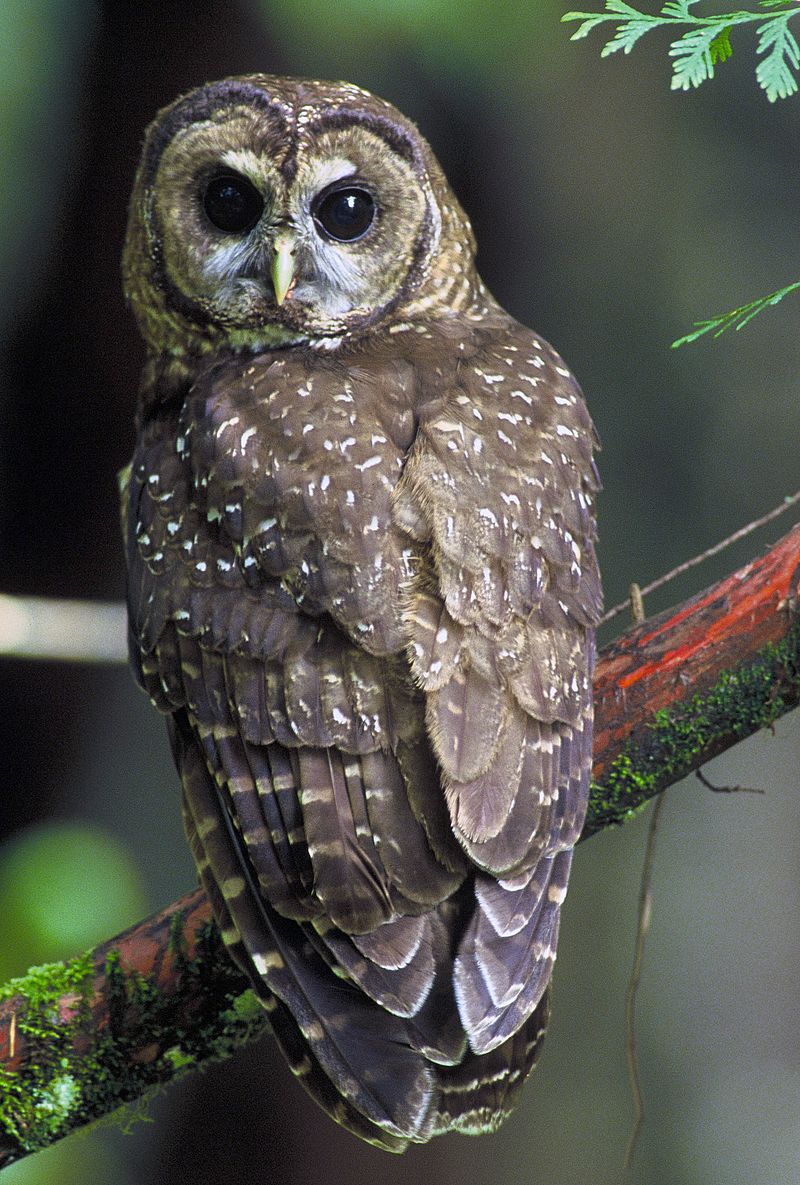
The Northern spotted owl is a medium-sized bird found in the Pacific Northwest region of North America. It is a subspecies of the Strix occidentalis and belongs to the family Strigidae.
This owl is dark brown in color and plays a crucial role as an indicator species.
However, the population of the Northern spotted owl continues to decline due to habitat destruction caused by humans, as well as competition with other animals.
This bird is known for its unique hoot call and has become an icon of the Pacific Northwest region.
Conservation efforts are underway to protect this species and its habitat from further destruction.Scientific classification:
| Kingdom | Animalia |
| Phylum | Chordata |
| Class | Aves |
| Order | Strigiformes |
| Family | Strigidae |
| Genus | Strix |
| Species | S. occidentalis |
| Subspecies | S. o. caurina |